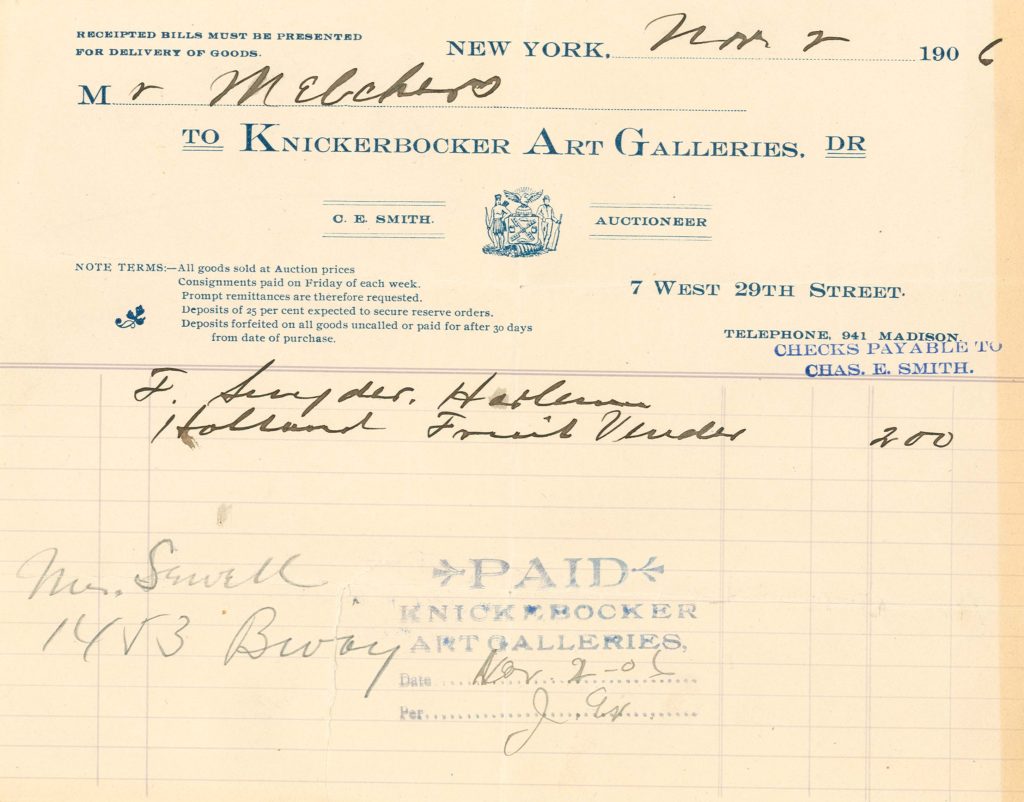 Sometimes when our guests enter the dining room and encounter the monumental painting Market Scene (above, 12′ x 7′) they profess to having seen it somewhere before. Are they imagining it? Probably not! Many of our guests are true globetrotters who might be thinking of a near-duplicate of the painting seen in the collection of Munich’s Alte Pinakotek or Bantry House, County Cork, Ireland.
Sometimes when our guests enter the dining room and encounter the monumental painting Market Scene (above, 12′ x 7′) they profess to having seen it somewhere before. Are they imagining it? Probably not! Many of our guests are true globetrotters who might be thinking of a near-duplicate of the painting seen in the collection of Munich’s Alte Pinakotek or Bantry House, County Cork, Ireland.
The Flemish painter Frans Snyders (1579-1657) painted a set of four market compositions around 1635. Snyders was a master of still life, particularly of food and animal subjects, in which he showcased the virtuosity of his skill. The subject was also designed to appeal to the interests of the patrons who commissioned the works, landed gentry whose households depended heavily on the production and preparation of food and who never tired of displaying their “embarassment of riches.”
In 1769 Snyders’ 4-painting set was sold to Catherine the Great and now hangs in the Hermitage Museum in St. Petersburg, Russia. The theme of profusely-laid market stalls proved very popular and Snyders’ workshop produced faithful copies, under Snyders’ own supervision and with the participation of Snyders himself, particularly in the area of the faces.
One such workshop copy, Market Scene, depicting a female vendor and huntsman surrounded by an abundance of fruits and vegetables, is at Gari Melchers Home and Studio. It has been authenticated by the National Gallery of Art’s curator of Northern European painting, Arthur Wheelock. The Munich and Bantry House copies have also been authenticated as period studio productions.
There is much to be read in the symbolism of the painting at Belmont. The market woman offers the young man a fig, apparently an obscene gesture referencing the fertility of the womb. And the produce was actually placed according to a hierarchy of rarity. The most valued fruits and vegetables were contained in precious Chinese porcelains at the top of the compostition, while the fruits of the earth, root vegetables, for example, were relegated to the ground. Exotic flower bulbs were placed at the very top of the composition while a monkey, considered a mischievous scavenger, appears at the bottom margin.
 Another subject from the Hermitage Museum set is the Fruit Market (above), depicting a rather grand lady selecting an apricot from the basket of an old crone. It was purchased by Sir George Bowes of Streatlam Castle and Gibside (County Durham) about 1750 for 1500 guineas. The Bowes estate passed into the possession of the Strathmore family in the second half of the 18th century and it hangs today in the Billiard Room at the family seat, Glamis Castle, Angus, Scotland. If the Bowes name is familiar, that is because it is the family name of the former Queen Mum, Elizabeth Bowes Lyon, daughter of the 14th Earl and Countess of Strathmore. GMHS learned of this version after being visited by the Queen Mother’s niece, Mary, Countess of Strathmore and Kinghorne in 1994.
Another subject from the Hermitage Museum set is the Fruit Market (above), depicting a rather grand lady selecting an apricot from the basket of an old crone. It was purchased by Sir George Bowes of Streatlam Castle and Gibside (County Durham) about 1750 for 1500 guineas. The Bowes estate passed into the possession of the Strathmore family in the second half of the 18th century and it hangs today in the Billiard Room at the family seat, Glamis Castle, Angus, Scotland. If the Bowes name is familiar, that is because it is the family name of the former Queen Mum, Elizabeth Bowes Lyon, daughter of the 14th Earl and Countess of Strathmore. GMHS learned of this version after being visited by the Queen Mother’s niece, Mary, Countess of Strathmore and Kinghorne in 1994.
Gari Melchers, always a fan of old master paintings, purchased Market Scene at the Knickerbocker Art Galleries, New York, in 1906 for $200, well before he even knew Belmont existed. The monumental painting must have gone into storage until he moved
 stateside in 1915. In 1933 Mrs. Melchers had a portion of the canvas at the bottom margin removed by a conservator because of rot. In another conservation effort dating to the mid-1980s, it was discovered that the vase of flowers in the niche above the vendor was painted out. The vase was uncovered at this time.
stateside in 1915. In 1933 Mrs. Melchers had a portion of the canvas at the bottom margin removed by a conservator because of rot. In another conservation effort dating to the mid-1980s, it was discovered that the vase of flowers in the niche above the vendor was painted out. The vase was uncovered at this time.

[…] most altered by the Melchers. Paint archeology revealed that the cupboard to the left of the Frans Snyders painting was a freestanding piece of furniture before it became a fixture in 1916. The Melchers then had a […]